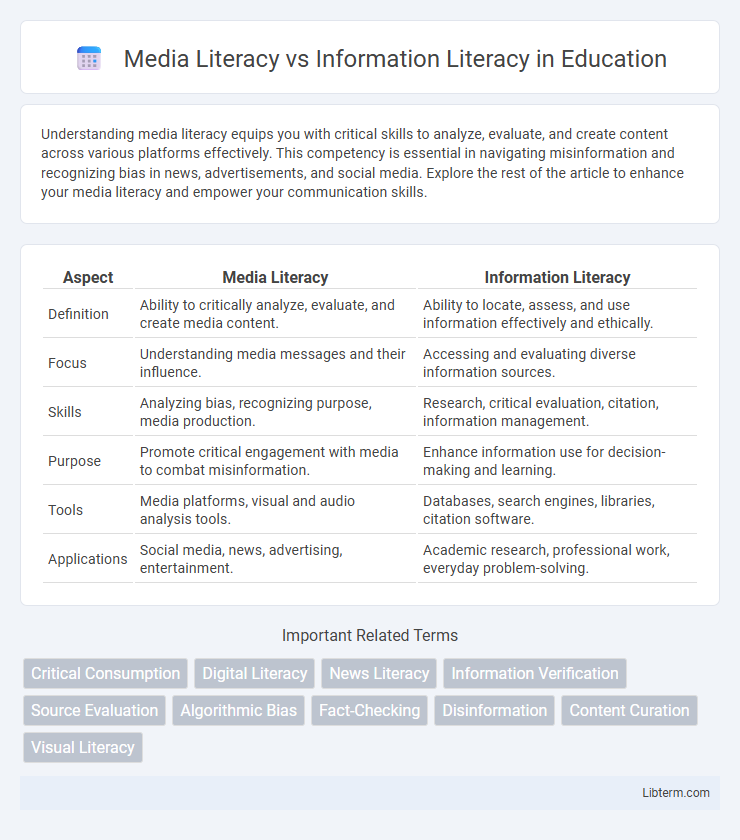Understanding media literacy equips you with critical skills to analyze, evaluate, and create content across various platforms effectively. This competency is essential in navigating misinformation and recognizing bias in news, advertisements, and social media. Explore the rest of the article to enhance your media literacy and empower your communication skills.
Table of Comparison
| Aspect | Media Literacy | Information Literacy |
|---|---|---|
| Definition | Ability to critically analyze, evaluate, and create media content. | Ability to locate, assess, and use information effectively and ethically. |
| Focus | Understanding media messages and their influence. | Accessing and evaluating diverse information sources. |
| Skills | Analyzing bias, recognizing purpose, media production. | Research, critical evaluation, citation, information management. |
| Purpose | Promote critical engagement with media to combat misinformation. | Enhance information use for decision-making and learning. |
| Tools | Media platforms, visual and audio analysis tools. | Databases, search engines, libraries, citation software. |
| Applications | Social media, news, advertising, entertainment. | Academic research, professional work, everyday problem-solving. |
Understanding Media Literacy
Understanding media literacy involves the ability to critically analyze and evaluate various forms of media content, including news, advertisements, and social media messages. It empowers individuals to recognize bias, identify misinformation, and discern the purpose behind media messages, enhancing informed decision-making. Mastery of media literacy skills supports responsible consumption and production of media, fostering a more informed and engaged society.
Defining Information Literacy
Information literacy involves the ability to locate, evaluate, and effectively use information from various sources to solve problems or make decisions. It emphasizes critical thinking skills to assess the credibility, relevance, and accuracy of data in digital and traditional formats. Mastering information literacy supports informed citizenship and academic success in an increasingly data-driven world.
Key Differences Between Media and Information Literacy
Media literacy emphasizes the ability to critically analyze, evaluate, and create content in various media formats such as television, social media, and digital platforms, focusing on understanding bias, messaging techniques, and the impact of media on society. Information literacy concentrates on the skills needed to locate, evaluate, and use information effectively from diverse sources like books, academic journals, and databases, highlighting research methods and source credibility. Key differences lie in media literacy's focus on content interpretation and communication in mass media, while information literacy centers on research skills and the ethical use of information in academic and professional contexts.
Historical Development of Each Concept
Media literacy originated in the early 20th century with the rise of mass communication technologies, emphasizing critical consumption of newspapers, radio, and television to combat propaganda and misinformation. Information literacy emerged later in the 1970s alongside the growth of libraries and digital information systems, focusing on the ability to locate, evaluate, and use information effectively in academic and professional contexts. Both literacies evolved to address changing technological landscapes, with media literacy adapting to digital media and social networks, while information literacy incorporates digital research skills and data management.
Core Skills in Media Literacy
Core skills in media literacy encompass the ability to critically analyze media messages, evaluate sources for credibility, and understand the purpose behind content creation. Media literacy requires interpreting visual and textual information, recognizing bias, and distinguishing between fact and opinion across various platforms. These skills empower individuals to navigate digital environments effectively, enhancing their capacity to make informed decisions in an information-saturated world.
Core Skills in Information Literacy
Core skills in information literacy include the ability to locate, evaluate, and effectively use information from diverse sources, emphasizing critical thinking and digital competency. These skills enable individuals to navigate complex information environments, discern credible from unreliable data, and apply information ethically and legally. In contrast to media literacy, which centers on interpreting and analyzing media content across platforms, information literacy focuses more broadly on managing information throughout its lifecycle to solve problems and make informed decisions.
The Role of Technology in Both Literacies
Technology serves as a pivotal tool in advancing both media literacy and information literacy by providing access to diverse digital platforms and resources. It enables critical evaluation of multimedia content and fosters skills to discern credible information from misinformation across social media, news sites, and academic databases. Integration of AI-driven algorithms further enhances personalized learning experiences, promoting deeper understanding and effective navigation in the digital information landscape.
Challenges in Teaching Media and Information Literacy
Teaching media literacy and information literacy faces challenges such as rapidly evolving digital technologies and the pervasive spread of misinformation on social media platforms. Educators struggle with engaging diverse student populations who have varying levels of digital skills and pre-existing biases influenced by echo chambers. Limited resources and insufficient training further hinder effective instruction in critical evaluation of sources and responsible content consumption.
Practical Applications in Daily Life
Media literacy equips individuals with skills to critically analyze and evaluate diverse media messages, fostering informed consumption of news, advertisements, and social content. Information literacy emphasizes the ability to locate, assess, and effectively use information from various sources, essential for research, decision-making, and problem-solving in everyday life. Together, these literacies enhance practical applications such as discerning credible news, avoiding misinformation, and efficiently navigating digital environments for reliable data retrieval.
Future Trends in Media and Information Literacy
Future trends in media and information literacy emphasize the integration of artificial intelligence (AI) and machine learning tools to enhance critical thinking and fact-checking skills. Emerging digital platforms demand adaptive literacy frameworks that address misinformation, data privacy, and ethical content creation. Collaborative international initiatives are accelerating the development of standardized curricula to empower users in navigating complex media ecosystems effectively.
Media Literacy Infographic

 libterm.com
libterm.com